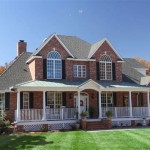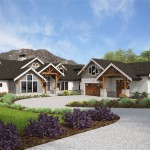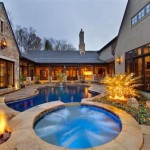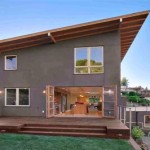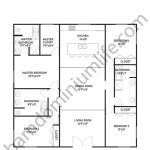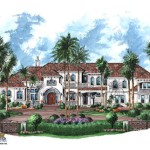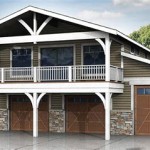Small Guest House Design Plans: Maximizing Space and Comfort
The growing popularity of short-term rentals and the desire to accommodate visiting friends and family have fueled a significant interest in small guest house design plans. These structures, often referred to as accessory dwelling units (ADUs), granny flats, or backyard cottages, offer a practical and often cost-effective solution for increasing living space without the expense of a full-scale home addition. Careful planning and a focus on efficient design principles are crucial in creating a comfortable and functional guest house within a limited footprint.
Designing a small guest house requires a thoughtful approach to space utilization, material selection, and adherence to local building codes and zoning regulations. The aim is to create a self-contained living space that provides guests with privacy, comfort, and all the necessary amenities while minimizing the impact on the primary residence's property value and aesthetic appeal. This article will explore key considerations for small guest house design plans, highlighting strategies for maximizing space and creating a welcoming environment.
Key Point 1: Defining the Purpose and Scope
Before embarking on the design process, it is essential to clearly define the purpose and intended use of the guest house. This will significantly influence the size, layout, and features incorporated into the design. Consider the following questions:
Will the guest house primarily serve as accommodation for visiting family and friends, or will it be used as a short-term rental property? The answer will dictate the level of privacy and amenities required. For instance, a rental property might benefit from a separate entrance and a fully equipped kitchen, whereas a guest house for family may share laundry facilities with the main house.
What is the anticipated occupancy? Is the guest house intended for single occupancy, couples, or small families? This will determine the size and configuration of the sleeping area, bathroom, and living space.
What are the specific needs of potential users? Consider accessibility requirements, such as wheelchair ramps or wider doorways, if the guest house will be used by elderly or disabled individuals. Also, think about the need for specific amenities like a workspace or a designated area for hobbies.
What is the budget for the project? Establishing a realistic budget early on will help guide design decisions and prevent cost overruns. This includes not only the construction costs but also permit fees, material costs, and potential landscaping expenses.
By clearly defining the purpose and scope of the guest house, architects and designers can create a tailored plan that meets the specific needs of the owner and future occupants while staying within budget constraints.
Key Point 2: Maximizing Space Through Design Strategies
Given the limited square footage of a small guest house, effective space-saving strategies are paramount. This involves carefully planning the layout, selecting appropriate furniture, and incorporating multi-functional elements.
Open floor plans can significantly enhance the feeling of spaciousness. By combining the living, dining, and kitchen areas into a single open space, the design eliminates the need for dividing walls, creating a more airy and inviting atmosphere. This allows for better flow and natural light distribution throughout the guest house.
Loft spaces can be utilized for sleeping areas or storage, freeing up valuable floor space for other uses. A loft bed, accessed by a ladder or stairs, can be a practical solution for maximizing space in a small guest house. Alternatively, a loft could serve as a storage area for seasonal items or belongings.
Vertical storage solutions are essential for maximizing space in a small guest house. Tall bookshelves, wall-mounted cabinets, and hanging organizers can provide ample storage without taking up valuable floor space. Consider using vertical space in the bathroom for shelving and storage above the toilet or sink.
Multi-functional furniture is another key element in small guest house design. Sofa beds, folding tables, and ottoman storage units can serve multiple purposes, maximizing the utility of limited space. Consider using furniture with built-in storage compartments to further enhance space efficiency.
Careful consideration should be given to the scale of furniture and appliances. Opt for smaller, space-saving appliances and furniture pieces that are proportioned to the size of the guest house. Avoid bulky or oversized items that can overwhelm the limited space.
Lighting plays a crucial role in creating the illusion of spaciousness. Natural light should be maximized through the use of large windows and skylights. Strategically placed artificial lighting, such as recessed lighting and wall sconces, can further enhance the ambiance and create a more inviting atmosphere. Avoid cluttering the space with floor lamps that take up valuable floor space.
Key Point 3: Prioritizing Functionality and Comfort
While maximizing space is important, it is equally crucial to prioritize functionality and comfort in the design of a small guest house. The goal is to create a space that is both efficient and enjoyable to live in.
The kitchen, even in a small guest house, should be functional and well-equipped. Consider incorporating a compact refrigerator, a two-burner cooktop, a microwave, and a small sink. Optimize storage space by using pull-out shelves and vertical organizers. A well-designed kitchen will allow guests to prepare meals comfortably without feeling cramped.
The bathroom should be designed with efficiency and comfort in mind. A compact shower or shower-tub combination can save space. Consider using a wall-mounted sink and toilet to maximize floor space. Good ventilation is essential to prevent moisture buildup and maintain a comfortable environment. Ensure adequate lighting and storage for toiletries and personal items.
Adequate insulation is crucial for maintaining a comfortable temperature throughout the year. Proper insulation will help regulate the temperature in the guest house, reducing energy consumption and improving overall comfort. Consider using energy-efficient windows and doors to further enhance insulation.
Ventilation is also important for maintaining indoor air quality. Ensure that the guest house is properly ventilated to prevent moisture buildup and improve air circulation. This can be achieved through the use of operable windows, vents, and a properly sized exhaust fan in the bathroom.
Soundproofing can enhance privacy and minimize noise transmission between the guest house and the main residence. Consider using soundproofing materials in the walls, floors, and ceilings to reduce noise levels and create a more peaceful environment.
Finally, don't forget about the exterior space surrounding the guest house. A small patio or deck can provide a valuable outdoor living area for guests to relax and enjoy the surroundings. Landscaping can also enhance the aesthetic appeal of the guest house and create a more inviting environment.
Careful planning and attention to detail are essential for creating a small guest house that is both functional and comfortable. By maximizing space, prioritizing functionality, and incorporating thoughtful design elements, it is possible to create a welcoming and enjoyable living space for guests or renters.
Furthermore, it's important to stay informed about local building codes and zoning regulations. These regulations dictate the permissible size, height, and location of guest houses on a property. It's crucial to obtain the necessary permits before starting construction to avoid any legal issues down the line. Consulting with a local architect or contractor can help ensure that the design complies with all applicable regulations.
In addition to building codes, consider the impact of the guest house on the surrounding environment. Sustainable design practices can minimize the environmental footprint of the structure. This includes using recycled materials, incorporating energy-efficient appliances, and implementing water conservation measures. Solar panels can also be installed to generate electricity, reducing reliance on the electrical grid. By incorporating sustainable design principles, the guest house can be both environmentally friendly and cost-effective in the long run.
The placement of the guest house on the property should also be carefully considered. Ideally, the guest house should be located in a way that maximizes privacy for both the occupants of the main residence and the guests. Consider the orientation of the guest house to take advantage of natural sunlight and minimize exposure to harsh weather conditions. Planting trees and shrubs can provide additional privacy and enhance the aesthetic appeal of the property.
The design of a small guest house presents a unique opportunity to create a functional and comfortable living space within a limited footprint. By carefully considering the purpose and scope of the project, maximizing space through creative design strategies, and prioritizing functionality and comfort, it is possible to create a welcoming and enjoyable environment for guests or renters. Remember to consult with professionals and adhere to local regulations to ensure a successful and compliant project.

Cozy Log Cabins Nestled In Currant Ridge

Historic Shed Cottage Tiny House Floor Plans Guest

Guesthouse Plans For A Small 2 Bedroom Lakeside Cabin

Cozy Guest House Floor Plan Perfect Retreat For Family And Friends

Plan 73931 Detached Guest House Or Tiny With Photos

Studio400 Tiny Guest House Plan 61custom Contemporary Modern Plans

Guest House Plans Truoba Architects

Guest House Plans 12x16 She Shed Man Cave

Casita Guest House Floorplan Los Angeles By American Building Innovation Lp Houzz Au

Pin By Katherine Lumb On Tiny Houses How To Plan House Plans Building A Small

